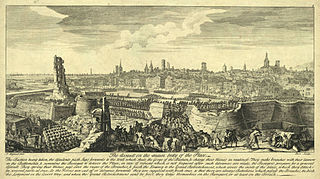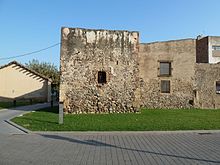
The Peninsular War (1807–1814) was the military conflict fought in the Iberian Peninsula by Spain, Portugal, and the United Kingdom against the invading and occupying forces of the First French Empire during the Napoleonic Wars. In Spain, it is considered to overlap with the Spanish War of Independence. The war started when the French and Spanish armies invaded and occupied Portugal in 1807 by transiting through Spain, and it escalated in 1808 after Napoleonic France occupied Spain, which had been its ally. Napoleon Bonaparte forced the abdications of Ferdinand VII and his father Charles IV and then installed his brother Joseph Bonaparte on the Spanish throne and promulgated the Bayonne Constitution. Most Spaniards rejected French rule and fought a bloody war to oust them. The war on the peninsula lasted until the Sixth Coalition defeated Napoleon in 1814, and is regarded as one of the first wars of national liberation. It is also significant for the emergence of large-scale guerrilla warfare.

Cambrils is a coastal town in the comarca of Baix Camp, province of Tarragona, Catalonia, Spain. The town is near the tourist town Salou and is frequently visited by those travelling by air using Reus Airport.

Pau Claris i Casademunt was a Catalan lawyer, clergyman and 94th President of the Deputation of the General of Catalonia at the beginning of the Catalan Revolt. On 16 January 1641 he proclaimed the Catalan Republic under the protection of France.

The siege of Haarlem was an episode of the Eighty Years' War. From 11 December 1572 to 13 July 1573 an army of Philip II of Spain laid bloody siege to the city of Haarlem in the Netherlands, whose loyalties had begun wavering during the previous summer. After the naval battle of Haarlemmermeer and the defeat of a land relief force, the starving city surrendered and the garrison was massacred. The resistance nonetheless was taken as an heroic example by the Orangists at the sieges of Alkmaar and Leiden.

The Manila massacre, also called the Rape of Manila, involved atrocities committed against Filipino civilians in the City of Manila, the capital of the Philippines, by Japanese troops during the Battle of Manila which occurred during World War II. The total number of civilians who were killed was at least 100,000.

The Reapers' War, also known as the Catalan Revolt, was a conflict that affected the Principality of Catalonia between the years of 1640 and 1659. It had an enduring effect in the Treaty of the Pyrenees (1659), which ceded the County of Roussillon and the northern half of the County of Cerdanya to France, splitting these northern Catalan territories off from the Principality of Catalonia and the Crown of Aragon, and thereby receding the borders of Spain to the Pyrenees.
The Battle of Badajoz was one of the first major engagements of the Spanish Civil War, resulting in a tactical and strategic Nationalist victory, however at a significant cost in time and troops. After several days of shelling and bombardment, Nationalists stormed the fortified border city of Badajoz on August 14, 1936, cutting off the Spanish Republic from neighbouring Portugal and linking the northern and southern zones of Nationalist control.

The Battle of Almenar also referred to as Almenara was a battle in the Iberian theatre of the War of the Spanish Succession.

The siege of Barcelona was a thirteen month battle at the end of the War of Spanish Succession, which pitted Archduke Charles of Austria against Philip V of Spain, backed by France in a contest for the Spanish crown.

The third siege of Girona occurred in northern Catalonia, Spain from 6 May to 12 December 1809, during the Napoleonic Wars. A significant event of the Peninsular War, France's Grande Armée lay siege to the town of Girona for seven months. Girona was strategically important because it controlled the main road between France and Spain.

The Battle of Villalar was a battle in the Revolt of the Comuneros fought on 23 April 1521 near the town of Villalar in Valladolid province, Spain. The royalist supporters of King Charles I won a crushing victory over the comuneros rebels. Three of the most important rebel leaders were captured, Juan de Padilla, Juan Bravo, and Francisco Maldonado. They were executed the next day, effectively ending armed resistance to Charles I.

The Battle of Montjuïc took place on 26 January 1641 during the Reapers' War. A Spanish force under Pedro Fajardo launched an attack on the Catalan army led by Francesc de Tamarit, with French cavalry support. The Spanish force had recently massacred hundreds of rebels who had tried to surrender at Cambrils.

The Naval battle of Barcelona was a naval engagement of the Franco-Habsburg War fought off Barcelona from 29 June to 3 July 1642 between a Spanish fleet commanded by Juan Alonso Idiáquez, Duke of Ciudad Real, and a French fleet under Jean Armand de Maillé-Brézé, Duc de Fronsac.
In a three-day battle, Brézé defeated the Spanish fleet, which was attempting to relieve some Spanish garrisons isolated along the Catalan coast, and forced the Duke of Ciudad Real to retreat to Majorca for repairs. As usual in most of the battles involving Maillé-Brézé, the French fleet made an extensive use of her fireships. This time, however, a large French vice-flagship, the Galion de Guise, fell victim to one of his own fireships and went down enveloped in flames. The victory, in any case, was for the French fleet, and its main long-term effect was the fall of Perpignan into the hands of the Franco-Catalan army.

The fourth siege of Badajoz took place from July to October 1658 during the Portuguese Restoration War. It was an attempt by a huge Portuguese army under the command of Joanne Mendes de Vasconcelos, governor of Alentejo, to capture the Spanish city of Badajoz, which was the headquarters of the Spanish Army of Extremadura. The fortifications of Badajoz were essentially medieval and considered vulnerable by the Portuguese, and had already been attacked by them three times during this war.
The Battle of Tarragona of August 1641 was a naval battle that took place between 20 – 25 August 1641, between the Spanish and French fleets during the French stage of the Thirty Years' War. The Spanish fleet, led by the Duke of Fernandina and the Duke of Maqueda broke the French naval blockade over Tarragona and defeated the French fleet under Henri d'Escoubleau de Sourdis, forcing it to retreat. The city was also besieged by land since April by a Franco-Catalan army commanded by Philippe de La Mothe-Houdancourt. The Spanish success in driving Sourdis out of the area, together with the arrival of a relief force sent by land, forced the Franco-Catalan army to leave the siege, and to retreat to Valls, pursued by the Spanish army.
The siege of Gandesa took place between July and November 1938 during the Spanish Civil War, a few months after a battle in the same town.

Montjuïc Castle is an old military fortress, with roots dating back from 1640, built on top of Montjuïc hill in Barcelona, Catalonia, Spain. It currently serves as a Barcelona municipal facility.

On the afternoon of 17 August 2017, 22-year-old Younes Abouyaaqoub drove a van into pedestrians on La Rambla street in Barcelona, Catalonia, Spain killing 13 people and injuring at least 130 others, one of whom died 10 days later on 27 August. Abouyaaqoub fled the attack on foot, then killed another person in order to steal the victim's car to make his escape.

The Battle of Martorell is one of the episodes of the Reapers' War in Catalonia that took place from 20 to 23 January 1641 and ended in a victory for the Spanish troops.















